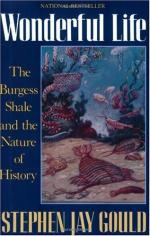|
This section contains 716 words (approx. 2 pages at 400 words per page) |

|
Chapter 4, Walcott's Vision and the Nature of History Summary and Analysis
The animating mystery of this chapter is why Walcott ever interprets the Burgess Shale according to the ladder and the cone in the first place. Walcott is easily one of the greatest scientists in American history, so this is a powerful question for Gould. Walcott has largely disappeared from memory, in large part because he was a well-known administrator at the Smithsonian and excellent administrators are quickly forgotten.
Gould reviews Walcott's biography. He is "an American success story." He is raised fairly poor near Utica, New York, and born in 1850. He becomes a professional scientist by selling some trilobite specimens he discovers on a farm to Louis Agassize, the greatest natural historian in American history. He then takes up a job in 1876, as assistant to a New...
(read more from the Chapter 4, Walcott's Vision and the Nature of History Summary)
|
This section contains 716 words (approx. 2 pages at 400 words per page) |

|




